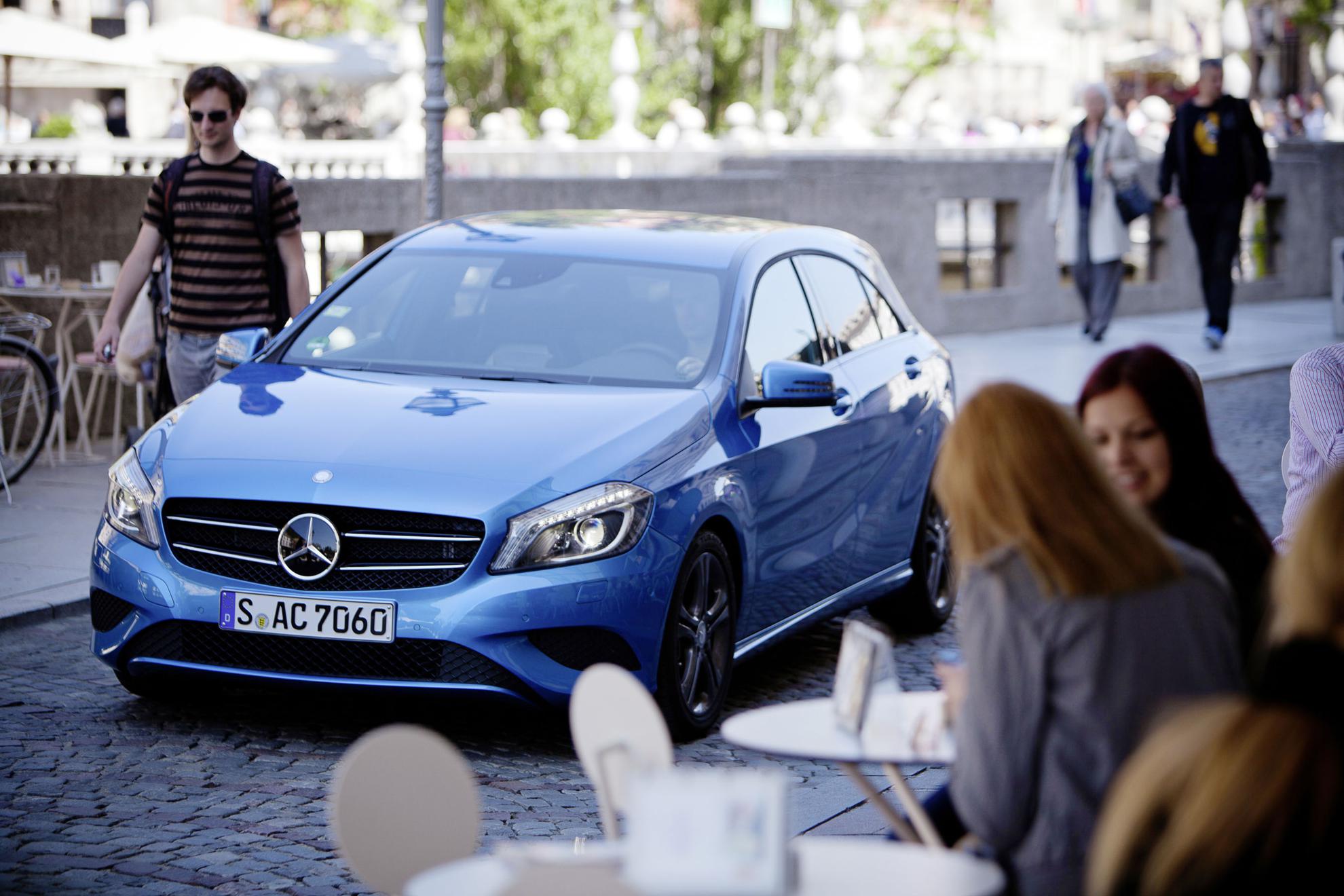Passive safety – A strong basis and intelligent protection
“One star is all you need” – the Mercedes-Benz safety philosophy also applies to the new Mercedes Benz A-Class. Its safety equipment, some features of which are traditionally found in much higher vehicle categories, includes belt tensioners and belt force limiters for the rear seats. Included is the standard PRE-SAFE® anticipatory occupant protection system and the active bonnet for pedestrian protection. The line-up also includes seven airbags as standard.

The new Mercedes Benz A-Class has passed the brand’s rigorous programme of crash tests. This includes not only some 30 different impact configurations, which are laid down as requirements for safety ratings and international type approval, but also nine proprietary crash tests, such as the roof-drop test or the pole impact test, developed by the brand itself.
The ability of the new Mercedes Benz A-Class to satisfy requirements which go far beyond the statutory conditions in some cases is also demonstrated by an internal offset front collision test against a future luxury-segment saloon from Mercedes-Benz: despite the high impact speed and the fact that it is the smaller accident participant, the
offers its occupants an intact passenger compartment and excellent chances of survival.
The bodyshell structure provides the basis for the high standard of passive safety, both in terms of material – the proportion of high-strength and ultra-high-strength sheet steel stands at 67 percent – and with regard to its structural design. Key features of the front-end structure are the systematic implementation of an available crash length of 435 millimetres, load distribution over several planes, the new bulkhead and floor concept and the subframe as a deformation element.
A total of three longitudinal member planes – consisting of the straight front longitudinal members, a second, upper plane attached to the front end consisting of extruded aluminium box sections and a third plane at the bottom in front of the subframe – allow impact energy to be reduced in a controlled manner.

The subframe provides the torque support for the transverse engine / transmission block and serves to attach the components for the front axle and steering. It consists of several steel plates, some in ultra-high-strength steel, and a hydroformed tube. In order to optimise its deformation properties, the subframe is connected via two aluminium struts leading forward to the
aluminium radiator mount located under the front end. In the event of a frontal impact, forces can be discharged at an early juncture into the subframe via this third load path, in order to ensure the best possible energy dissipation.
A plastic crash wedge which is fitted at the rear of the front wheel arches helps to ensure that the wheels do not slide under the front doors in the event of a high-impact crash, irrespective of the turning angles. This means that it will be possible to open the doors, even after a serious accident.
The bulkhead also incorporates a special feature: so-called “skate runners” in front of the two middle longitudinal members discharge forces into the floor. The continuous floor structure consists of a total of four straight longitudinal members. The tunnel roof reinforcements at front and rear combine with the tunnel to provide a further closed profile supporting the front end.
Controlled deformation: protection in side-on crashes
Rigid side structures and defined deformation management help to safeguard the survival space for occupants in the event of a side impact. Elements here include the so-called “pole support”, a member fitted diagonally in the rear footwell between centre tunnel and floor side wall which is intended to prevent the floor from being torn open in the event of side impact with a tree.
High-strength steels are used in the upper area of the B-pillar in order to minimise intrusion and to preserve the passenger cell in case of side impact. The lower area of the B-pillar is softer, in the interests of energy dissipation. The safety experts at Mercedes-Benz have christened the crack management system on the insides of the B-pillar “vampire teeth”. In a serious side-on crash, the seat belt retractor presses against the inner wall of the B-pillar. To prevent this from leading to a transverse crack which might affect structural integrity, small, tooth-like recesses define the crack direction.
Pedestrian protection: comprehensive measures including Active Bonnet
The protection of those road users who are most at risk has always been a top priority during the development of Mercedes passenger cars. The new Mercedes Benz A-Class features numerous protective measures designed to help lessen the risk of injury to pedestrians. In order to reduce the loads which arise in the event of a pedestrian impact on the bonnet of the vehicle, the deformation space between the bonnet and the components beneath it has been optimised. This is achieved in part through the appropriate positioning of components such as control units or fluid reservoirs in the engine compartment.
In the case of the Mercedes Benz A-Class, with its sporty, low-slung body, an active bonnet is also used. In the event of a pedestrian impact, sophisticated sensors combined with intelligent algorithms trigger actuators in the area of the bonnet hinges. These raise the bonnet by 65 millimetres. The additional space which this creates between the bonnet and the components in the engine compartment means that a head is subject to comparatively low internal acceleration forces on impact.
The deformation characteristics of the bonnet have been developed specifically to meet these requirements. Reductions in the impact loads can be achieved by using aluminium and reinforcing the inside face of the bonnet.
On all seats: intelligent restraint systems
The Mercedes Benz A-Class protects its passengers with up to nine airbags. The standard complement comprises driver and front-passenger airbag, a kneebag for the driver, large thorax-pelvisbags incorporated in the seat to protect the chest, stomach and pelvis area and windowbags. The windowbags extend over both rows of seats to the A-pillar triangle. They serve to protect the occupants’ heads from hard contact in the event of side impact and can also help to keep limbs inside the vehicle in an accident. The driver and front passenger airbags operate in two stages, according to the expected severity of the impact. The gas generator first of all fills the driver’s airbag with 60 and the front passenger’s airbag with 70 per cent gas. If a more severe impact is forecast, the second stage of the gas generator will additionally be activated after a delay and the airbags will be filled at a higher pressure level. Sidebags for the rear are
optionally available.
The high safety expertise of the Mercedes Benz A-Class’s developers is reflected in a host of details. The deformable steering column yields by up to 100 millimetres when the driver exerts pressure on the airbag as a result of forward displacement in an accident, for example. The comfort features also reveal a fine touch: the driver’s airbag is connected to a vibration absorber in the steering wheel to reduce vibrations, for example.
The head restraints for driver and front passenger are new developments. The onus in developing the new restraints was on further reducing the risk of whiplash injury. Key to effective whiplash prevention is the best possible adjustment of the distance from the rear of the occupants’ heads. The restraint incorporates a button for this purpose on the left-hand side (as seen in the
direction of travel). This release mechanism can be pressed to unlock the head restraint and increase the distance between head and head restraint. The button does not need to be pressed in order to reduce the distance. This enables single-handed operation in all adjustment positions.
Family-friendly: comprehensive precautionary measures in the rear
In developing the new Mercedes Benz A-Class, the Mercedes-Benz safety experts have also attached great importance to the safety of the rear-seat occupants. The new model therefore meets the relevant requirements of the Japanese and Chinese NCAP institutes which also take account of factors such as the ease of use of the rear seat belts. Experts believe that Euro NCAP will extend its rating
programme to include rear-seat safety in the medium term. The Mercedes Benz A-Class is already prepared for this and is a role model in this respect – both within and beyond its own vehicle category – with features such as standard-fit belt tensioners and belt force limiters for the outer rear seats. A torsion bar in the roller mechanism twists when the load on it exceeds a defined level. In this way the belt force is limited and with it the load on the seat occupant.
The Mercedes Benz A-Class’s family-friendly features also include the ISOFIX child seat securing system on the outer seats. Child seats can additionally be fixed to the vehicle by means of special anchorage points with top tethers.
Innovation in the compact class: anticipatory occupant protection system
The PRE-SAFE® anticipatory occupant protection system is available in the Mercedes Benz A-Class for the first time. This represents a further step in the on-going democratisation of this innovation, which was premiered in the S-Class in 2002.
PRE-SAFE® from Mercedes-Benz uses the time between detection of a potential accident situation and a possible collision to initiate preventive protection measures, thus reducing the loads exerted on the occupants in the event of a crash by up to 40 percent.
Core features of PRE-SAFE® are reversible belt tensioning, the closing of side windows and sliding sunroof when critical lateral dynamics are detected and adjustment of the fully electric front passenger seat with memory function to an ideal position for maximum effectiveness of the restraint systems.
PRE-SAFE® is activated when one of the following parameters is met: emergency braking, panic braking, pronounced over- or understeering, critical steering movements or heavy support by adaptive Brake Assist.
Mercedes-Benz automatic emergency call system: faster assistance at the scene of an accident
In combination with COMAND Online, the new Mercedes Benz A-Class is equipped with the Mercedes-Benz emergency call system. As long as COMAND Online is connected to a mobile phone, the Mercedes-Benz emergency call system can automatically alert the emergency services within a matter of minutes in the event of a serious accident.
After the airbags or belt tensioners are triggered, the vehicle’s exact GPS position and vehicle identification number (VIN) are sent by SMS to a special emergency centre, with positional data also being transmitted using the DTMF method (dual-tone multi-frequency) at the same time. Even if the occupants are unconscious or unsure of exactly where they are because they are on a holiday trip, for example, the emergency services alerted by the emergency centre will be notified quickly with accurate information. The driver can also make the emergency call manually as “MB emergency call” is always the first entry in the system phone directory.
On receiving the call, the emergency centre establishes voice contact with the vehicle occupants in a matter of seconds. A particularly practical aspect in an emergency is that the communication is held not in the language of the country where the accident has occurred but in the language which the driver has preset in COMAND Online.
Other than any mobile phone communication charges, which would only arise in the event of an actual emergency call, no charges are incurred by the driver for the emergency call facility and no contractual relationship – other than the regular mobile phone contract – is required.


